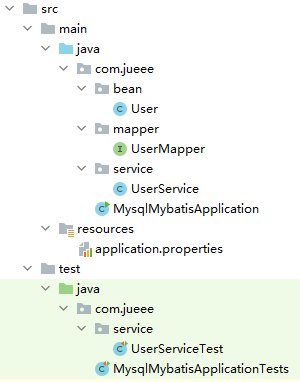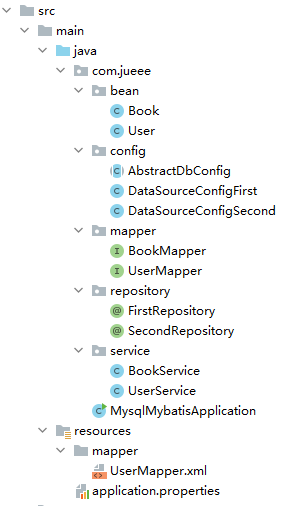SpringBoot 通过 Druid 集成 Tkmybatis
Tkmybatis 介绍
Tk mybatis 可以极大的方便开发人员。可以随意的按照自己的需要选择通用方法,还可以很方便的开发自己的通用方法。
极其方便的使用 MyBatis 单表的增删改查。
支持单表操作,不支持通用的多表联合查询。
- GitHub:https://github.com/abel533/Mapper
- JavaDoc:https://apidoc.gitee.com/free/Mapper/
引入依赖
<dependency>
<groupId>tk.mybatis</groupId>
<artifactId>mapper-spring-boot-starter</artifactId>
<version>2.1.5</version>
</dependency>常见使用
忽略属性
在需要忽略的属性上增加 @transient 注解
javax.persistence.Transient;
transient 是类型修饰符,只能用来修饰字段。在对象序列化过程中, 被 @Transient 标记的变量不会被序列化
@Transient
private String res_typeInfo;Tkmybatis 单数据源
配置文件:
spring.datasource.driverClassName=com.mysql.cj.jdbc.Driver spring.datasource.url=jdbc:mysql://127.0.0.1:3306/vuedb?serverTimezone=UTC spring.datasource.username=xxx spring.datasource.password=xxxBean
import lombok.Data; import javax.persistence.GeneratedValue; import javax.persistence.Id; import javax.persistence.Table; @Data @Table(name = "user") public class User { @Id @GeneratedValue(generator = "JDBC") private Long id; private String username; private String nickname; private String email; private String phoneNumber; private Integer status; }Mapper
import com.jueee.bean.User; import org.apache.ibatis.annotations.Select; import tk.mybatis.mapper.common.Mapper; public interface UserMapper extends Mapper<User> { @Select("select * from user where username=#{username}") User selectByUserName(String username); }Service
import com.jueee.bean.User; import com.jueee.mapper.UserMapper; import org.springframework.beans.factory.annotation.Autowired; import org.springframework.stereotype.Service; @Service public class UserService { @Autowired private UserMapper userMapper; public User selectById(int id){ return userMapper.selectByPrimaryKey(id); } public User selectByUserName(String username){ User user = new User(); user.setUsername(username); return userMapper.selectByUserName(username); } }Application
import org.springframework.boot.SpringApplication; import org.springframework.boot.autoconfigure.SpringBootApplication; import tk.mybatis.spring.annotation.MapperScan; @MapperScan("com.jueee.mapper") //扫描的mapper @SpringBootApplication public class MysqlMybatisApplication { public static void main(String[] args) { SpringApplication.run(MysqlMybatisApplication.class, args); } }Test
import com.jueee.bean.User; import lombok.extern.slf4j.Slf4j; import org.junit.jupiter.api.Test; import org.springframework.beans.factory.annotation.Autowired; import org.springframework.boot.test.context.SpringBootTest; @Slf4j @SpringBootTest public class UserServiceTest { @Autowired private UserService userService; @Test public void selectById(){ User user = userService.selectById(1); log.info(user.getNickname()); } @Test public void selectByUserName(){ User user = userService.selectByUserName("admin"); log.info(user.getEmail()+"-"+user.getNickname()); } }
目录结构

Tkmybatis 多数据源
相关配置如下:
使用注解方式,需要引入 druid 包:
<dependency> <groupId>com.alibaba</groupId> <artifactId>druid-spring-boot-starter</artifactId> <version>1.2.4</version> </dependency>配置文件
spring.datasource.first.driverClassName=com.mysql.cj.jdbc.Driver spring.datasource.first.jdbc-url=jdbc:mysql://127.0.0.1:3306/vuedb?serverTimezone=UTC spring.datasource.first.username=xxx spring.datasource.first.password=xxx spring.datasource.second.driverClassName=com.mysql.cj.jdbc.Driver spring.datasource.second.jdbc-url=jdbc:mysql://127.0.0.1:3306/test?serverTimezone=UTC spring.datasource.second.username=xxx spring.datasource.second.password=xxx mybatis.mapper-location=classpath*:mapper/*.xml数据源通用方法 AbstractDatasource:
import com.alibaba.druid.pool.DruidDataSource; import org.apache.ibatis.session.SqlSessionFactory; import org.mybatis.spring.SqlSessionFactoryBean; import org.springframework.core.io.Resource; import org.springframework.core.io.support.PathMatchingResourcePatternResolver; import org.springframework.core.io.support.ResourcePatternResolver; import javax.sql.DataSource; public abstract class AbstractDbConfig { protected SqlSessionFactory sqlSessionFactory(DataSource dataSource, String mapperLocation) throws Exception { SqlSessionFactoryBean factoryBean = new SqlSessionFactoryBean(); factoryBean.setDataSource(dataSource); ResourcePatternResolver resourceResolver = new PathMatchingResourcePatternResolver(); Resource[] resource= resourceResolver.getResources(mapperLocation); factoryBean.setMapperLocations(resource); return factoryBean.getObject(); } protected DataSource dataSourceFactory(String driveClassName, String url, String userName, String password){ DruidDataSource datasource = new DruidDataSource(); datasource.setDriverClassName(driveClassName); datasource.setUrl(url); datasource.setUsername(userName); datasource.setPassword(password); datasource.setMaxActive(20); datasource.setInitialSize(20); return datasource; } }对应不同的数据源,进行匹配。注:需引入
tk.mybatis.spring.annotation.MapperScan第一数据源配置如下:
import com.jueee.repository.FirstRepository; import org.mybatis.spring.SqlSessionTemplate; import org.springframework.beans.factory.annotation.Qualifier; import org.springframework.beans.factory.annotation.Value; import org.springframework.context.annotation.Bean; import org.springframework.context.annotation.Configuration; import org.springframework.context.annotation.Primary; import org.springframework.jdbc.datasource.DataSourceTransactionManager; import org.springframework.transaction.PlatformTransactionManager; import tk.mybatis.spring.annotation.MapperScan; import javax.sql.DataSource; @Configuration @MapperScan(basePackages = {"com.jueee"},annotationClass = FirstRepository.class, sqlSessionTemplateRef = "firstUserTemplate") public class DataSourceConfigFirst extends AbstractDbConfig { @Value("${spring.datasource.first.jdbc-url}") private String url; @Value("${spring.datasource.first.username}") private String userName; @Value("${spring.datasource.first.password}") private String password; @Value("${spring.datasource.first.driver-class-name}") private String driveClassName; @Value(value = "${mybatis.mapper-location}") private String mapperLocation; @Bean(name = "firstUser") public DataSource secondaryDataSource() { return dataSourceFactory(driveClassName, url, userName, password); } @Primary @Bean(name = "firstUserTemplate") public SqlSessionTemplate firstUserSqlTemplate() throws Exception { return new SqlSessionTemplate((sqlSessionFactory(secondaryDataSource(), mapperLocation))); } @Bean @Qualifier("firstUserTransaction") public PlatformTransactionManager firstUserTransaction() { return new DataSourceTransactionManager(secondaryDataSource()); } }第二数据源配置如下:
import com.jueee.repository.SecondRepository; import org.mybatis.spring.SqlSessionTemplate; import org.springframework.beans.factory.annotation.Qualifier; import org.springframework.beans.factory.annotation.Value; import org.springframework.context.annotation.Bean; import org.springframework.context.annotation.Configuration; import org.springframework.jdbc.datasource.DataSourceTransactionManager; import org.springframework.transaction.PlatformTransactionManager; import tk.mybatis.spring.annotation.MapperScan; import javax.sql.DataSource; @Configuration @MapperScan(basePackages = {"com.jueee"},annotationClass = SecondRepository.class, sqlSessionTemplateRef = "secondUserTemplate") public class DataSourceConfigSecond extends AbstractDbConfig { @Value("${spring.datasource.second.jdbc-url}") private String url; @Value("${spring.datasource.second.username}") private String userName; @Value("${spring.datasource.second.password}") private String password; @Value("${spring.datasource.second.driver-class-name}") private String driveClassName; @Value(value = "${mybatis.mapper-location}") private String mapperLocation; @Bean(name = "secondUser") public DataSource secondaryDataSource() { return dataSourceFactory(driveClassName, url, userName, password); } @Bean(name = "secondUserTemplate") public SqlSessionTemplate secondUserSqlTemplate() throws Exception { return new SqlSessionTemplate((sqlSessionFactory(secondaryDataSource(), mapperLocation))); } @Bean @Qualifier("secondUserTransaction") public PlatformTransactionManager secondUserTransaction() { return new DataSourceTransactionManager(secondaryDataSource()); } }定义注解,分别作为不同数据库的表识。
import org.apache.ibatis.annotations.Mapper; import org.springframework.stereotype.Component; import java.lang.annotation.*; @Documented @Retention(RetentionPolicy.RUNTIME) @Target(ElementType.TYPE) @Component @Mapper public @interface FirstRepository { String value() default ""; }import org.apache.ibatis.annotations.Mapper; import org.springframework.stereotype.Component; import java.lang.annotation.*; @Documented @Retention(RetentionPolicy.RUNTIME) @Target(ElementType.TYPE) @Component @Mapper public @interface SecondRepository { String value() default ""; }Bean:
com.jueee.bean.User类:import lombok.Data; import javax.persistence.GeneratedValue; import javax.persistence.Id; import javax.persistence.Table; @Data @Table(name="user") public class User { @Id @GeneratedValue(generator = "JDBC") private Long id; private String username; private String nickname; private String email; private String phoneNumber; private Integer status; }com.jueee.bean.Book类:import lombok.Data; import javax.persistence.GeneratedValue; import javax.persistence.Id; import javax.persistence.Table; @Data @Table(name="book") public class Book { @Id @GeneratedValue(generator = "JDBC") private Long id; private String author; private String description; private String title; }Mapper
com.jueee类:import com.jueee.bean.User; import com.jueee.repository.FirstRepository; import tk.mybatis.mapper.common.Mapper; import java.io.Serializable; @FirstRepository public interface UserMapper extends Mapper<User> { User selectByUserName(Serializable id); }import com.jueee.bean.Book; import com.jueee.repository.SecondRepository; import tk.mybatis.mapper.common.Mapper; @SecondRepository public interface BookMapper extends Mapper<Book> { }Service 类如下:
import com.jueee.bean.Book; import com.jueee.mapper.BookMapper; import org.springframework.beans.factory.annotation.Autowired; import org.springframework.stereotype.Service; import java.util.List; @Service public class BookService { @Autowired private BookMapper bookMapper; public List<Book> selectAll(){ return bookMapper.selectAll(); } }import com.jueee.bean.User; import com.jueee.mapper.UserMapper; import org.springframework.beans.factory.annotation.Autowired; import org.springframework.stereotype.Service; @Service public class UserService { @Autowired private UserMapper userMapper; public User selectById(int id){ return userMapper.selectByPrimaryKey(id); } public User selectByUserName(String username){ return userMapper.selectByUserName(username); } }自定义
selectByUserName方法对应的 Mapping.xml :<?xml version="1.0" encoding="UTF-8"?> <!DOCTYPE mapper PUBLIC "-//mybatis.org//DTD Mapper 3.0//EN" "http://mybatis.org/dtd/mybatis-3-mapper.dtd"> <mapper namespace="com.jueee.mapper.UserMapper"> <select id="selectByUserName" resultType="com.jueee.bean.User"> select * from user where username = #{username} </select> </mapper>测试类如下:
import com.jueee.bean.Book; import com.jueee.bean.User; import lombok.extern.slf4j.Slf4j; import org.junit.jupiter.api.Test; import org.springframework.beans.factory.annotation.Autowired; import org.springframework.boot.test.context.SpringBootTest; import java.util.List; @Slf4j @SpringBootTest public class UserServiceTest { @Autowired private UserService userService; @Autowired private BookService bookService; @Test public void selectUserById(){ User user = userService.selectById(1); log.info(user.getNickname()); } @Test public void selectByUserName(){ User user = userService.selectByUserName("admin"); log.info(user.getEmail()+"-"+user.getNickname()); } @Test public void selectAllBook(){ List<Book> list = bookService.selectAll(); list.forEach(t->log.info(t.getAuthor())); } }
目录结构

问题解决
报错:

解决办法,不是导入 org.mybatis.spring.annotation.MapperScan,应该导入 tk.mybatis.spring.annotation.MapperScan 包。

相关文章